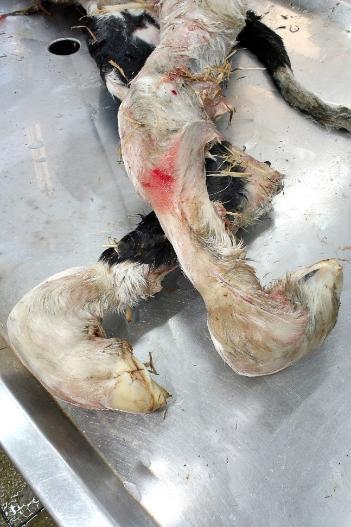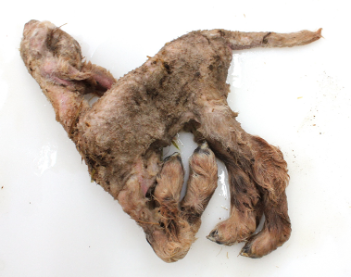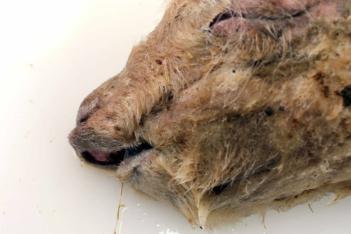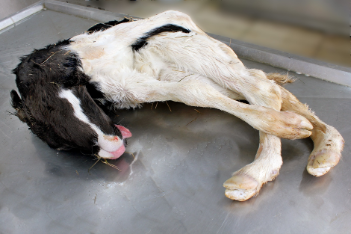Schmallenberg Virus investigations. Department urges investigation of any birth deformities seen in calves or lambs this spring.
The Department of Agriculture Food and the Marine’s Regional Veterinary Laboratories (RVLs) have confirmed several cases of Schmallenberg virus (SBV), a midge-borne virus that can cause birth deformities in lambs and calves. This follows the detection of Schmallenberg virus (SBV) in several investigations into milk drop and diarrhoea in herds across the country in the summer and autumn of 2024 which indicated virus circulation.
To date, birth deformities associated with SBV have been confirmed in counties Galway, Offaly and Cavan affecting early lambing sheep flocks.
SBV was first recognised in Germany and the Netherlands during the summer of 2011. The first case was detected in Ireland in October 2012. It spread across from Europe, carried by wind-borne infected midges.
In Ireland, as with other affected countries, the impact of the disease was short-term, after immunity built up in cattle and sheep through exposure. Since, there have been a small number of outbreaks. This has been a low-impact disease overall, except on a small number of farms where animals were infected at the stage of pregnancy when the foetus in utero is most susceptible to the effects of the virus. This unfortunately resulted in the birth of deformed off-spring.
Anecdotal evidence from Europe suggests that SBV exposure in utero has also been associated with the birth of apparently normal calves and lambs with reduced viability, i.e. although born normal, they showed increased morbidity to other diseases and had lower growth and survival rates. Therefore, apart from the ‘visible’ losses of dead/deformed caves/lambs, advisors and farmers need to be aware of this potential hidden susceptibility, and neonatal husbandry, colostrum, biosecurity etc really needs to be optimised to prevent further losses on affected farms.
The RVLs are emphasising the value of ensuring that deformed calves and lambs are submitted to them for testing, to increase the intensity and sensitivity of surveillance for both Schmallenberg Virus and the potentially more impactful Bluetongue Virus (BTV). Both viruses can result in the birth of deformed offspring. Bluetongue has been detected in the UK and in Europe in the past two years. Bluetongue can cause a wide spectrum of clinical presentations, and it would risk causing significant animal welfare impacts as well as trade challenges if it became established here.
Both viruses can cause a wide variety of birth deformities, especially deformed limbs (arthrogryposis), spinal curvature (scoliosis), torticollis (twisted neck) shortened lower jaw (brachygnathia inferior) and domed skulls (hydranencephaly).
Some of these birth deformities can make natural calving or lambing very difficult or impossible and farmers should be alert to an increased risk of these ill effects in this season seeking veterinary intervention in a timely manner.

Photo 1: Deformed limbs (arthrogryposis in a Friesian calf caused by Schmallenberg Virus

Photo 2: Deformed limbs (arthrogryposis), torticollis (twisted neck) shortened lower jaw (brachygnathia inferior) in a lamb caused by Schmallenberg Virus
Bluetongue virus could come to Ireland through the wind-borne spread of infected midges, through the importation of infected animals or contaminated fomites or animal derived biological material (e.g. blood, semen).
Farmers are advised to be vigilant and to ask their vet to refer any birth deformities in sheep or cattle to the nearest RVL for investigation.

Photo 3: Shortened lower jaw (brachygnathia inferior) in a lamb caused by Schmallenberg Virus

Photo 4: Deformed limbs (arthrogryposis), spinal curvature (scoliosis), torticollis (twisted neck) shortened lower jaw (brachygnathia inferior) in a Friesian calf caused by Schmallenberg Virus.
Further information on Bluetongue and Schmallenberg viruses is available here:
- https://www.gov.ie/en/publication/cd6c0-bluetongue-virus/
- http://www.animalhealthsurveillance.agriculture.gov.ie/media/animalhealthsurveillance/content/programmes/Schmallenberg_16022021.pdf
All photos by Cosme Sanchez Miguel, Senior research officer, Cork Regional veterinary Laboratory






